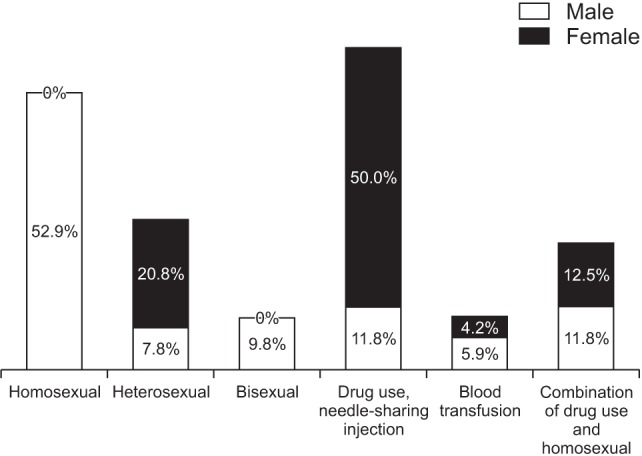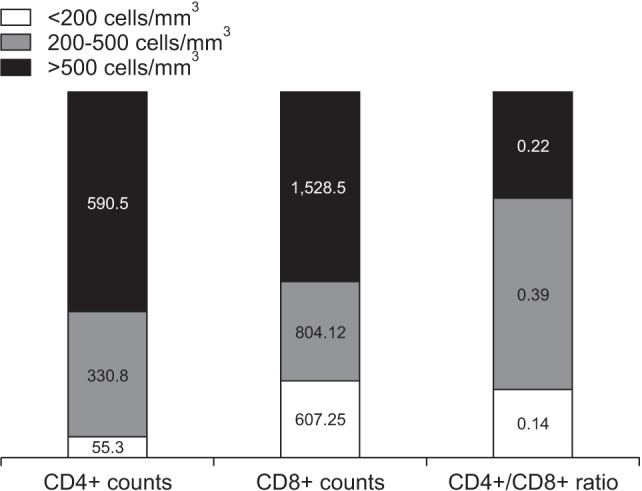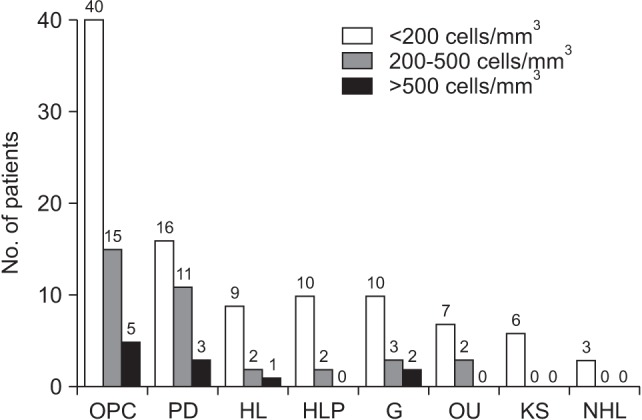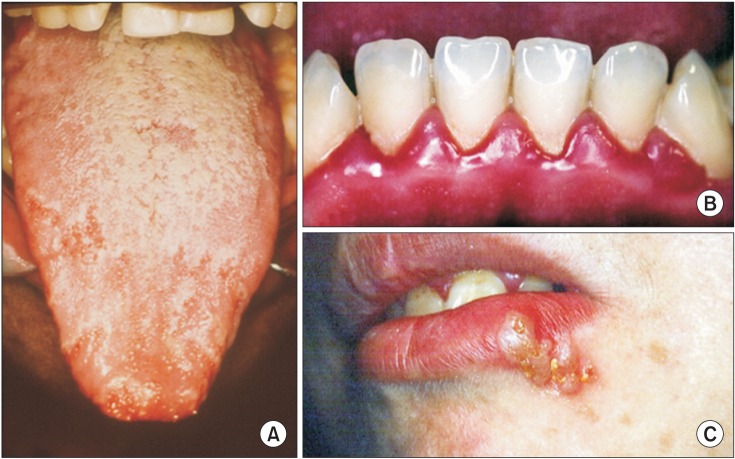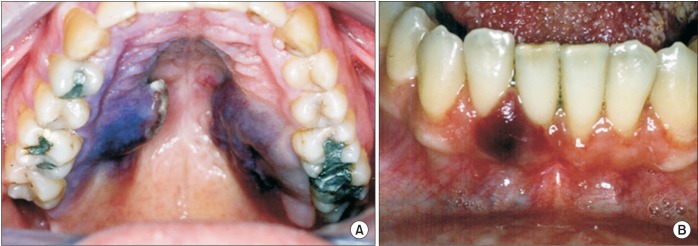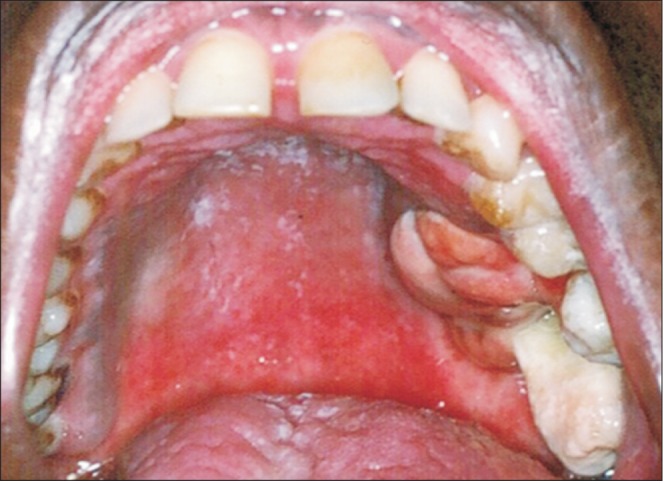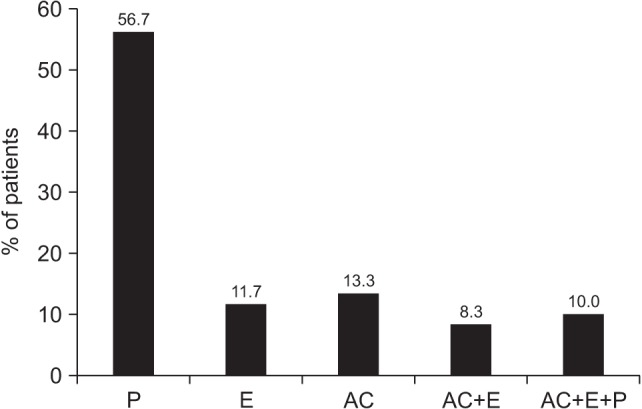J Korean Assoc Oral Maxillofac Surg.
2017 Dec;43(6):388-394. 10.5125/jkaoms.2017.43.6.388.
Oral lesions associated with human immunodeficiency virus in 75 adult patients: a clinical study
- Affiliations
-
- 1Department of Oral and Maxillofacial Surgery, School of Dentistry, Lebanese University, Beirut, Lebanon. anberberi@gmail.com
- 2Department of Oral Medicine and Diagnosis, School of Dentistry, Lebanese University, Beirut, Lebanon.
- KMID: 2398993
- DOI: http://doi.org/10.5125/jkaoms.2017.43.6.388
Abstract
OBJECTIVES
The objective of this study was to investigate the presence of oral lesions in human immunodeficiency virus/acquired immunodeficiency syndrome (HIV/AIDS) patients in a descriptive cross-sectional study, and to establish their presence according to levels of CD4+ cells (including the CD4+/CD8+ cell ratio).
MATERIALS AND METHODS
A total of 75 patients infected with HIV were included. Oral lesions were observed and classified using World Health Organization classification guidelines. Potential correlations between the presence and severity of oral lesions and CD4+ cells, including the CD4+/CD8+ cell ratio, were studied.
RESULTS
The most frequent oral lesion detected was oral pseudomembranous candidiasis (80.0%), followed by periodontal disease (40.0%), herpetic lesions (16.0%), hairy leukoplakia (16.0%), gingivitis (20.0%), oral ulceration (12.0%), Kaposi's sarcoma (8.0%), and non-Hodgkin's lymphoma (4.0%). The CD4+ count was <200 cells/mm³ in 45 cases (60.0%), between 200-500 cells/mm³ in 18 cases (24.0%), and >500 cells/mm³ in 12 cases (16.0%). The mean CD4+ count was 182.18 cells/mm³. The mean ratio of CD4+/CD8+ cells was 0.26. All patients showed at least one oral manifestation.
CONCLUSION
There was no correlation between the CD4+/CD8+ cell ratio and the presence of oral lesions. The severity of the lesions was more pronounced when the CD4+ cell count was less than 200 cells/mm³.
Keyword
MeSH Terms
Figure
Cited by 1 articles
-
Importance of various oral manifestations regardless of CD4 cell count in HIV/AIDS patients
Soung Min Kim, Jong Ho Lee
J Korean Assoc Oral Maxillofac Surg. 2018;44(6):298-301. doi: 10.5125/jkaoms.2018.44.6.298.
Reference
-
1. Patton L. Progress in understanding oral health and HIV/AIDS. Oral Dis. 2014; 20:223–225. PMID: 24344792.
Article2. Piot P, Quinn TC. Response to the AIDS pandemic--a global health model. N Engl J Med. 2013; 368:2210–2218. PMID: 23738546.3. UNAIDS. Global AIDS Response Progress Reporting 2016 [Internet]. Geneva: UNAIDS;2016. 1. cited 2017 Jul 21. Available from: https://aidsreportingtool.unaids.org/static/docs/GARPR_Guidelines_2016_EN.pdf.4. Nesti M, Carli E, Giaquinto C, Rampon O, Nastasio S, Giuca MR. Correlation between viral load, plasma levels of CD4-CD8 T lymphocytes and AIDS-related oral diseases: a multicentre study on 30 HIV+ children in the HAART era. J Biol Regul Homeost Agents. 2012; 26:527–537. PMID: 23034272.5. Patton LL, Ramirez-Amador V, Anaya-Saavedra G, Nittayananta W, Carrozzo M, Ranganathan K. Urban legends series: oral manifestations of HIV infection. Oral Dis. 2013; 19:533–550. PMID: 23517181.
Article6. Classification and diagnostic criteria for oral lesions in HIV infection. EC-Clearinghouse on Oral Problems Related to HIV Infection and WHO Collaborating Centre on Oral Manifestations of the Immunodeficiency Virus. J Oral Pathol Med. 1993; 22:289–291. PMID: 8229864.7. Petersen PE. Policy for prevention of oral manifestations in HIV/AIDS: the approach of the WHO Global Oral Health Program. Adv Dent Res. 2006; 19:17–20. PMID: 16672544.
Article8. Moniaci D, Greco D, Flecchia G, Raiteri R, Sinicco A. Epidemiology, clinical features and prognostic value of HIV-1 related oral lesions. J Oral Pathol Med. 1990; 19:477–481. PMID: 1981079.
Article9. Kolokotronis A, Kioses V, Antoniades D, Mandraveli K, Doutsos I, Papanayotou P. Immunologic status in patients infected with HIV with oral candidiasis and hairy leukoplakia. Oral Surg Oral Med Oral Pathol. 1994; 78:41–46. PMID: 8078662.
Article10. Berberi A, Noujeim Z, Aoun G. Epidemiology of oropharyngeal candidiasis in human immunodeficiency virus/acquired immune deficiency syndrome patients and CD4+ counts. J Int Oral Health. 2015; 7:20–23.11. Ramírez-Amador V, Esquivel-Pedraza L, Sierra-Madero J, Anaya-Saavedra G, González-Ramírez I, Ponce-de-León S. The changing clinical spectrum of human immunodeficiency virus (HIV)-related oral lesions in 1,000 consecutive patients: a 12-year study in a referral center in Mexico. Medicine (Baltimore). 2003; 82:39–50. PMID: 12544709.12. Berberi A, Noujeim Z. Epidemiology and relationships between CD4+ counts and oral lesions among 50 patients infected with human immunodeficiency virus. J Int Oral Health. 2015; 7:18–21.13. Park YJ, Nam JH, Noh KL, Pang EO, Kim DY, Kim JH, et al. Aids-associated kaposi's sarcoma on left lower retromolar triangle and parapharyngeal area: a case report. J Korean Assoc Oral Maxillofac Surg. 2009; 35:182–186.14. Vigneswaran N, Williams MD. Epidemiologic trends in head and neck cancer and aids in diagnosis. Oral Maxillofac Surg Clin North Am. 2014; 26:123–141. PMID: 24794262.
Article15. Bunn BK, van Heerden WF. HIV/AIDS associated malignancies of the head and neck. SADJ. 2012; 67:590–592. PMID: 23957103.16. Pakfetrat A, Falaki F, Delavarian Z, Dalirsani Z, Sanatkhani M, Zabihi Marani M. Oral manifestations of human immunodeficiency virus-infected patients. Iran J Otorhinolaryngol. 2015; 27:43–54. PMID: 25745611.17. Bravo IM, Correnti M, Escalona L, Perrone M, Brito A, Tovar V, et al. Prevalence of oral lesions in HIV patients related to CD4 cell count and viral load in a Venezuelan population. Med Oral Patol Oral Cir Bucal. 2006; 11:E33–E39. PMID: 16388291.18. Bodhade AS, Ganvir SM, Hazarey VK. Oral manifestations of HIV infection and their correlation with CD4 count. J Oral Sci. 2011; 53:203–211. PMID: 21712625.
Article19. Fanales-Belasio E, Raimondo M, Suligoi B, Buttò S. HIV virology and pathogenetic mechanisms of infection: a brief overview. Ann Ist Super Sanita. 2010; 46:5–14. PMID: 20348614.
Article20. Onakewhor JU, Olagbuji BN, Ande AB, Ezeanochie MC, Olokor OE, Okonofua FE. HIV-AIDS related maternal mortality in Benin City, Nigeria. Ghana Med J. 2011; 45:54–59. PMID: 21857722.
Article21. Taiwo OO, Hassan Z. The impact of Highly Active Antiretroviral Therapy (HAART) on the clinical features of HIV-related oral lesions in Nigeria. AIDS Res Ther. 2010; 7:19. PMID: 20579347.22. Zhou H, Zhao H, Hao Y, Song C, Han J, Zhang J, et al. Excessive conversion and impaired thymic output contribute to disturbed regulatory T-cell homeostasis in AIDS patients with low CD4 cell counts. AIDS. 2013; 27:1059–1069. PMID: 23299175.
Article23. Serrano-Villar S, Sainz T, Lee SA, Hunt PW, Sinclair E, Shacklett BL, et al. HIV-infected individuals with low CD4/CD8 ratio despite effective antiretroviral therapy exhibit altered T cell subsets, heightened CD8+ T cell activation, and increased risk of non-AIDS morbidity and mortality. PLoS Pathog. 2014; 10:e1004078. PMID: 24831517.
Article24. Margolick JB, Gange SJ, Detels R, O'Gorman MR, Rinaldo CR Jr, Lai S. Impact of inversion of the CD4/CD8 ratio on the natural history of HIV-1 infection. J Acquir Immune Defic Syndr. 2006; 42:620–626. PMID: 16868499.
Article25. Mocroft A, Bannister WP, Kirk O, Kowalska JD, Reiss P, D'Arminio-Monforte A, et al. The clinical benefits of antiretroviral therapy in severely immunocompromised HIV-1-infected patients with and without complete viral suppression. Antivir Ther. 2012; 17:1291–1300. PMID: 23013779.
Article26. Frimpong P, Amponsah EK, Abebrese J, Kim SM. Oral manifestations and their correlation to baseline CD4 count of HIV/AIDS patients in Ghana. J Korean Assoc Oral Maxillofac Surg. 2017; 43:29–36. PMID: 28280707.
Article27. Adurogbangba MI, Aderinokun GA, Odaibo GN, Olaleye OD, Lawoyin TO. Oro-facial lesions and CD4 counts associated with HIV/AIDS in an adult population in Oyo State, Nigeria. Oral Dis. 2004; 10:319–326. PMID: 15533205.
Article28. Thompson GR 3rd, Patel PK, Kirkpatrick WR, Westbrook SD, Berg D, Erlandsen J, et al. Oropharyngeal candidiasis in the era of antiretroviral therapy. Oral Surg Oral Med Oral Pathol Oral Radiol Endod. 2010; 109:488–495. PMID: 20156694.
Article
- Full Text Links
- Actions
-
Cited
- CITED
-
- Close
- Share
- Similar articles
-
- A Case of Ankylosing Spondylitis in a Patient with Human Immunodeficiency Virus
- Primary Rectal Amyloidosis in a Patient with Human Immunodeficiency Virus
- A Case of Neurosyphilis with Acute Optic Neuritis and Trochlear Nerve Palsy in Human Immunodeficiency Virus Infected Male
- Oral Manifestations of Human Immunodeficiency Virus Infection: Early Diagnostic Indicators
- Two Cases of Unusual Manifestations of Secondary Syphilis Accompanied by Human Immunodeficiency Virus Infection

